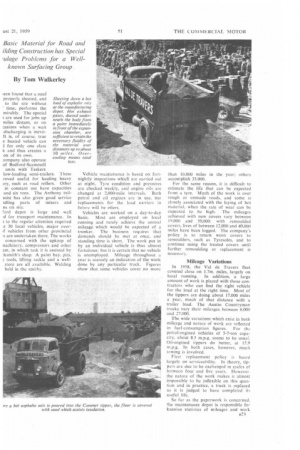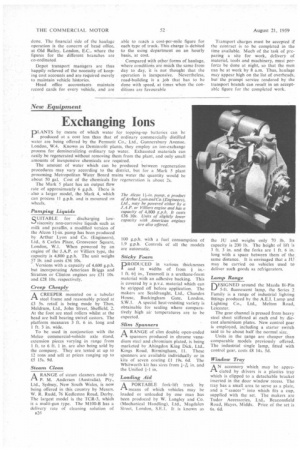A Hot-Stuff Transport Fleet
Page 56

Page 57

Page 58

If you've noticed an error in this article please click here to report it so we can fix it.
Basic Material for Road and ilding construction has Special !Wage Problems for a Wellknown Surfacing Group
By Tom Walkerley
TO the man who knows his Europe, the words Val de Travers indicate a remote Swiss valley close to the French frontier in the canton of Neuchatel. To the British driver, they are more usually connected with the warning boards that mark a hole in the road. Both travellers are equally perceptive: Val de Travers Asphalte, Ltd., take their name from the valley where an asphalte rock-mine concession was exploited as long ago as 1871.
Since those early days, the company have drawn their raw material from asphalte mines in France, Sicily and Germany. Today, the name is among the most familiar in the fields of road surfacing and building construction. With a number of associated companies, operating in the road-making industry, they have works and branches in London, Birmingham, Canterbury, Edinburgh, Exeter, Glasgow, Lincoln, Liverpool, Manchester and Newcastle.
Asphalte Mélange From the main works, at Sun Wharf. Deptford, London, there flows an increasing stream of asphalte materials of every kind, blended for a wide variety of uses. There are mixes for urban and rural roads, sonic applied hot and others coldrolled; there are mastic asphaltes for roofing, damp-proof coursing and flooring, and other preparations for footpaths, tennis courts and airport runways. It is a basic material for which modern construction methods find ever-increasing uses.
For the transport manager the nature of the product and the manner of its application present special problems. It is a business that requires speed throughout. To a certain extent, road work is dependent on weather and there are demands from the site for material and machinery that have to be met at once. The police, as much as the road-user,' view works in the arteries of a city with a jaundiced eye: they are to be completed with the minimum delay.
B22
The Val de Travers group maintains a transport fleet of more than 100 vehicles, about half of which are steelbodied tippers with towing hooks. The significance of the hooks is that there are also about 100 trailers, carrying mixers, rollers and other machinery. A dozen or so open trucks, of 3-ton capacity, are used for bulky loads. The workshops deal also with a fleet of 30 Austin light vans, used as service cars, personnel carriers, breakdown trucks and so on In essence, all the vehicles are multi-purpose.
No attempt has been made to standardize vehicles. Among the tippers are 5-ton and 7-ton Bedford, Commer, Austin and Dodge, but all, with the exception of two, have Anthony bodies and tipping gear. The exceptions are two 7-ton heated and insulated tipping bodies by J. H. Sparshatt and Sons (Southampton), Ltd.
These two vehicles were built to meet a specific need and have proved to he extremely satisfactory in nearly three years of service. Their purpose is to preserve a temperature of about 315° F. in a 7-ton load of asphalte, so that it could be laid, several miles away from the works, at about 275° F. Although asphalte tends to retain its heat for some time, a fall below a critical temperature makes the material unworkable and the load becomes a total loss.
The Sparshatt bodies have welded double skins, insulated with glass-fibre, and a boxed-in false floor beneath the load, through which exhaust gases are passed before reaching the twin tail pipes. The hot gas is ducted through a valve in front of the normal expansion chamber, mating with a conical intake on the under side of the body. During tipping, the upper cone detaches itself automatically from the lower spring-loaded cone and, on the return motion, seats itself to make a gas-tight seal. When this simple heating expedient is not required, the gas is exhausted in the normal way through the silencer by means of a valve operated by a rod on the side of the chassis.
For more everyday purposes, however,
■ een found that a steel properly sheeted, and to the site without time, performs the mirably. The special ; are used for jobs up miles distant, or on ;asions when a wait discharging is inevitIt is, of course, true e heated vehicle can i for only one class k and thus creates a on of its own.
;ompany also operate of Bcdford-Scammell units with' Taskers low-loading semi-trailers. These roved useful for hauling heavy try, such as road rollers. Other in constant use have capacities and six tons. The Anthony tailmist has also given good service idling parts of mixers and ns on site.
ford depot is large and well d for transport maintenance. In to the regular attention required e 30 local vehicles, major over f vehicles from other provincial s are undertaken there. The works concerned with the upkeep of nachinery, compressors and other ent, in which task it is assisted by :ksmith's shop. A paint bay, pits, tools, lifting tackle and a wellstore are all available. Welding held in the smithy.
Vehicle maintenance is based on fortnightly inspections whieft are carried out at night. Tyre condition and pressures are checked weekly, and engine oils are changed at 2,000-mile intervals. Both petrol and oil engines are in use, but replacements for the load carriers in future will be oilers.
Vehicles arc worked on a day-to-day basis. Most are employed on local running and rarely achieve the annual mileage which would be expected of a trunker. The business requires that demands should be met at once, and standing time is short. The work put in by an individual vehicle is thus almost fortuitous: but it is certain that no vehicle is unemployed. Mileage throughout a year is scarcely an indication of the work done by any particular truck. Figures show that some vehicles cover no more
than 10,000 miles in the year; others accomplish 35,000.
For the same reason, it is difficult to estimate the life that can be expected frorri a tyre. Much of the work is over rough or unmade roads, and some is closely associated with the laying of hot material, when the rate of wear can be expected to be high. The mileages achieved with new covers vary between 19,000 and 50,000: with remoulded covers, lives of between 12.000 and 40,000 miles have been logged. The company's policy is to return worn covers to remoulders, such as Tyresoles, and to continue using the treated covers until further remoulding or replacement is necessary.
Mileage Variations
In 1958, the Val de Travers fleet covered close on 1.7m. miles. largely on local running. In addition, a large amount of work is placed with those contractors who can find the right vehicle for the load at the right. time. Most of the tippers are doing about 17,000 miles a year, much of that distance with a trailer load. The Austin Countryman trucks vary their mileages between 8,000 and 27.000.
The wide variations which exist in both mileage and nature of work arc reflected in fuel-consumption figures. For the petrol-engined vehicles of 5-7-ton capacity, about 8.5 m.p.g. seems to be usual. Oil-engined tippers do better, at 15.9 m.p.g. In both cases, however, much towing is involved.
Fleet replacement policy is based largely on serviceability. In theory, tippers are due to be exchanged in cycles of between four and five years. However. the nature of the work makes it almost impossible to be inflexible on this question and in practice, a truck is replaced as it is judged to have completed its useful life.
So far as the paperwork is concerned, the maintenance depot is responsible for keenine statistics of mileages and work done. The financial side of the haulage operation is the concern of head office, at Old Bailey, London, E.C., where the Figures for the different branches are co-ordinated Depot transport managers arc thus happily relieved of the necessity of keeping cost accounts and are required merely to maintain vehicle histories.
Head office accountants maintain record cards for every vehicle, and are able to reach a cost-per-mile figure for each type of truck. This charge is debited to the using department on an hourly basis, at cost.
Compared with other forms of haulage, where conditions are much the same from day to day, it is not thought that the operation is inexpensive. Nevertheless, road-building is a job that has to be done with speed, at times when the conditions are favourable
Transport charges must be accepted if the contract is to be completed in the time available. Much of the task of preparing a site for work, delivery of material, tools and machinery, must perforce he done at night, so that the men can be at work by 8 a.m. Thus, haulage may appear high on the list of overheads, but the prompt service rendered by the transport branch can result in an acceptable figure for the completed work.




































































































